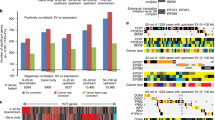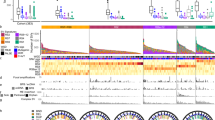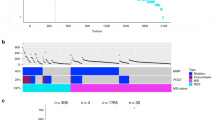Abstract
Prior studies have identified recurrent oncogenic mutations in colorectal adenocarcinoma1 and have surveyed exons of protein-coding genes for mutations in 11 affected individuals2,3. Here we report whole-genome sequencing from nine individuals with colorectal cancer, including primary colorectal tumors and matched adjacent non-tumor tissues, at an average of 30.7× and 31.9× coverage, respectively. We identify an average of 75 somatic rearrangements per tumor, including complex networks of translocations between pairs of chromosomes. Eleven rearrangements encode predicted in-frame fusion proteins, including a fusion of VTI1A and TCF7L2 found in 3 out of 97 colorectal cancers. Although TCF7L2 encodes TCF4, which cooperates with β-catenin4 in colorectal carcinogenesis5,6, the fusion lacks the TCF4 β-catenin–binding domain. We found a colorectal carcinoma cell line harboring the fusion gene to be dependent on VTI1A-TCF7L2 for anchorage-independent growth using RNA interference-mediated knockdown. This study shows previously unidentified levels of genomic rearrangements in colorectal carcinoma that can lead to essential gene fusions and other oncogenic events.
This is a preview of subscription content, access via your institution
Access options
Subscribe to this journal
Receive 12 print issues and online access
$209.00 per year
only $17.42 per issue
Buy this article
- Purchase on SpringerLink
- Instant access to full article PDF
Prices may be subject to local taxes which are calculated during checkout



Similar content being viewed by others
References
Fearon, E.R. & Vogelstein, B. A genetic model for colorectal tumorigenesis. Cell 61, 759–767 (1990).
Sjöblom, T. et al. The consensus coding sequences of human breast and colorectal cancers. Science 314, 268–274 (2006).
Wood, L.D. et al. The genomic landscapes of human breast and colorectal cancers. Science 318, 1108–1113 (2007).
Clevers, H. Wnt/B-Catenin signaling in development and disease. Cell 127, 469–480 (2006).
Nishisho, I. et al. Mutations of chromsome 5q21 genes in FAP and colorectal cancer patients. Science 253, 665–669 (1991).
Kinzler, K.W. et al. Identification of FAP locus genes from chromosome 5q21. Science 253, 661–665 (1991).
Markowitz, S.D. & Bertagnolli, M.M. Molecular basis of colorectal cancer. N. Engl. J. Med. 361, 2449–2460 (2009).
Ogino, S. & Goel, A. Molecular classification and correlates in colorectal cancer. J. Mol. Diagn. 10, 13–27 (2008).
The Cancer Genome Atlas Research Network. Integrated genomic analyses of ovarian carcinoma. Nature 474, 609–615 (2011).
Berger, M.F. et al. The genomic complexity of primary human prostate cancer. Nature 470, 214–220 (2011).
Chapman, M. et al. Initial genome sequencing and analysis of multiple myeloma. Nature 471, 467–472 (2011).
Lee, W. et al. The mutation spectrum revealed by paired genome sequences from a lung cancer patient. Nature 465, 473–477 (2010).
Pleasance, E.D. et al. A comprehensive catalogue of somatic mutations from a human cancer genome. Nature 463, 191–196 (2010).
Boland, C.R. et al. A National Cancer Institute workshop on microsatellite instability for cancer detection and familial predisposition: development of international criteria for the determination of microsatellite instability in colorectal cancer. Cancer Res. 58, 5248–5257 (1998).
Stephens, P.J. et al. Complex landscapes of somatic rearrangement in human breast cancer genomes. Nature 462, 1005–1010 (2009).
Stephens, P.J. et al. Massive genomic rearrangement acquired in a single catastrophic event during cancer development. Cell 144, 27–40 (2011).
Bignell, G.R. et al. Signatures of mutation and selection in the cancer genome. Nature 463, 893–898 (2010).
Beroukhim, R. et al. The landscape of somatic copy-number alteration across human cancers. Nature 463, 899–905 (2010).
Soda, M. et al. Identification of the transforming EML4-ALK fusion gene in non-small cell lung cancer. Nature 448, 561–566 (2007).
Tomlins, S.A. et al. Recurrent fusion of TMPRSS2 and ETS transcription factor genes in prostate cancer. Science 310, 644–648 (2005).
Kreykenbohm, V. et al. The SNAREs vti1a and vti1b have distinct localization and SNARE complex partners. Eur. J. Cell Biol. 81, 273–280 (2002).
Waterman, M.L. Lymphoid enhancer factor/T cell factor expression in colorectal cancer. Cancer Metastasis Rev. 23, 41–52 (2004).
Korinek, V. et al. Constitutive transcriptional activation by a β-Catenin-Tcf complex in APC−/− colon carcinoma. Science 275, 1784–1787 (1997).
Kriegl, L. et al. LEF-1 and TCF4 expression correlate inversely with survival in colorectal cancer. J. Transl. Med. 8, 123 (2010).
Folsom, A.R. et al. Variation in TCF7L2 and increased risk of colon cancer: the Atherosclerosis Risk in Communities (ARIC) Study. Diabetes Care 31, 905–909 (2008).
Hazra, A. et al. Association of the TCF7L2 polymorphism with colorectal cancer and adenoma risk. Cancer Causes Control 19, 975–980 (2008).
Tuupanen, S. et al. The common colorectal cancer predisposition SNP rs6983267 at chromosome 8q24 confers potential to enhanced Wnt signaling. Nat. Genet. 41, 885–890 (2009).
Pomerantz, M.M. et al. The 8q24 cancer risk variant rs6983267 shows long-range interaction with MYC in colorectal cancer. Nat. Genet. 41, 882–884 (2009).
Roose, J. et al. Synergy between tumor suppressor APC and the B-Catenin-Tcf4 target Tcf1. Science 285, 1923–1926 (1999).
Van de Wetering, M. et al. The β-Catenin/TCF-4 complex imposes a crypt progenitor phenotype on colorectal cancer cells. Cell 111, 241–250 (2002).
Tang, W. et al. A genome-wide RNAi screen for Wnt/B-catenin pathway components identifies unexpected roles for TCF transcription factors in cancer. Proc. Natl. Acad. Sci. USA 105, 9697–9702 (2008).
Angus-Hill, M.L. et al. T-cell factor 4 functions as a tumor suppressor whose disruption modulates colon cell proliferation and tumorigenesis. Proc. Natl. Acad. Sci. USA 108, 4914–4919 (2011).
Krzywinski, M. et al. Circos: an informative aesthetic for comparative genomics. Genome Res. 19, 1639–1645 (2009).
Firestein, R. et al. CDK8 is a colorectal cancer oncogene that regulates β-catenin activity. Nature 455, 547–551 (2008).
The Cancer Genome Atlas Research Network. Comprehensive genomic characterization defines human glioblastoma genes and core pathways. Nature 455, 1061–1068 (2008).
Chiang, D.Y. et al. High-resolution mapping of copy-number alterations with massively parallel sequencing. Nat. Methods 6, 99–103 (2009).
Ley, T.J. et al. DNA sequencine of a cytogenetically normal acute myeloid leukemia genome. Nature 456, 66–72 (2008).
Moffat, J. et al. A lentiviral RNAi library for human and mouse genes applied to an arrayed viral high-content screen. Cell 124, 1283–1298 (2006).
Bass, A.J. et al. SOX2 is an amplified lineage-survival oncogene in lung and esophageal squamous cell carcinoma. Nat. Genet. 41, 1238–1242 (2009).
Acknowledgements
We thank all members of the Biological Samples Platform and DNA Sequencing Platforms of the Broad Institute, without whose work this sequencing project could not have occurred, and R. Shivdasani and M. Freedman for helpful discussion. This work was supported by US National Institutes of Health grant K08CA134931 (A.J.B.), a GI SPORE Developmental Project Award (P50CA127003; M.M.) and the National Human Genome Research Institute (E.S.L.).
Author information
Authors and Affiliations
Contributions
A.J.B., M.S.L., A.H.R., Y.D., K.C., A.S., T.P., R.J., D.V., G.S., R.G.V. and N. Stransky performed computational analysis. J. Barretina, J. Baselga, J.J., J.T., D.B.S., E.V., D.Y.C., W.G.K. and S.S. provided samples for analysis. A.J.B., L.E.B., Y.M. and W.S. performed laboratory experiments. A.T.B., Y.H., M.W., N.S., R.A.D., W.C.H., C.S.F. and S.O. provided expert guidance regarding the analysis. C.S., M.P., L.C., L.A.G., S.G. and E.S.L. supervised and designed the sequencing effort. A.J.B., M.S.L., E.S.L., G.G. and M.M. designed the study, analyzed the data and prepared the manuscript. All coauthors reviewed and commented on the manuscript.
Corresponding authors
Ethics declarations
Competing interests
M.M., L.A.G. and E.S.L. are equity-holding founding advisors of Foundation Medicine. M.M. and L.A.G. consult for Novartis. M.M. is also a patent holder on the use of EGFR mutations in lung cancer licensed to Genzyme Genetics. W.S., Y.M. and M.W. are employees of Novartis.
Supplementary information
Supplementary Text and Figures
Supplementary Figures 1 and 2, Supplementary Tables 2, 3 and 5 and Supplementary Note. (PDF 882 kb)
Supplementary Table 1
Non-synonymous Mutations and Insertions/Deletions Identified Within Coding Genes (XLSX 185 kb)
Supplementary Table 4
Somatic Rearrangements Identified with dRanger Algorithm (XLSX 146 kb)
Rights and permissions
About this article
Cite this article
Bass, A., Lawrence, M., Brace, L. et al. Genomic sequencing of colorectal adenocarcinomas identifies a recurrent VTI1A-TCF7L2 fusion. Nat Genet 43, 964–968 (2011). https://doi.org/10.1038/ng.936
Received:
Accepted:
Published:
Issue Date:
DOI: https://doi.org/10.1038/ng.936



